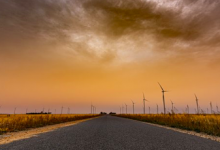Victoria has added more large-scale renewable electricity generation than any other State over the last decade.
The Government has also set targets, which it has said it will legislate, that 65% of Victoria’s electricity generation must be from renewable sources by 2030, and 95% by 2035.
Two new transmission projects, known as WRL-VNI, will be by far the biggest transmission project in Victoria in 50 years. Will they deliver outcomes that are consistent with these targets?
AEMO’s Consultation Report on WRL-WNI says that it expects that when WRL construction starts next year, Victoria will have a little over 6 GW of grid scale wind and solar generation (“variable renewable electricity – VRE” for short).
By 2030, with WRL complete and VNI under construction, AEMO says that Victoria will have a little under 8 GW of grid scale VRE.
By implication AEMO’s analysis says in that in Victoria grid-scale VRE will grow at the rate of around 300MW each year from the time that WRL begins construction (next year) until 2030. Is this good or bad?
Well, it is about one third as much VRE as has been added each year over the last five years in Victoria. In other words, AEMO projects that WRL-VNI will greatly retard VRE expansion in Victoria, in the period to 2030. What do you think about that?
What about in the years after both WRL and VNI-West are complete? AEMO’s analysis is no less disappointing. AEMO says that WRL-VNI will ultimately add 2,510 MW of VRE hosting capacity (850 MW in the Murray renewable energy zone REZ), and 1,550 MW in the Western Victoria REZ).
But to the end of the period it models (2050), it expects that only 1,650MW of new entry in these REZ zones.
Even then the average annual spillage, according to AEMO’s results over the full study period, is a nose-bleeding 34% for solar in the South West NSW REZ, 23% for solar in the Murray REZ and 26% for wind in the Western Victoria REZ.
Worked out as effective firm renewable capacity, according to AEMO’s analysis WRL-VNI adds just 1,209 MW.
But wait, it gets worse. AEMO’s flow duration curves on VNI (both the existing and the new VNI-West) show that these interconnectors will be running at more than 80% of their flow limit for 75% of the time by 2041, and for 90% of the time by 2050).
With such heavy flows, the marginal losses for VRE that connects to WRL-VNI will be at least 30% to 40%. So, not only must the 1,650 MW of new generation absorb 26% spills (wind) and 23-34% (solar) on average over the study period, they will also need to absorb prices that are 30% to 40% below market prices (the Regional Reference Node price) on account of their marginal loss factors.
If you were thinking about developing a wind farm in Western Victoria or a solar farm in the Murray REZ (or even if you already have a wind or solar farm there) do you really think WRL-VNI is a good thing?
Would you try to convince customers to pay twice as much for transmission services as they do now (which is what WRL-VNI will do) for such a meagre increase in VRE hosting capacity and continued high spills? Is it not reasonable for customers and affected landholders to reject WRL-VNI? Surely.
So why then does the Clean Energy Investor Group suggest WRL-VNI is “urgently needed”? How can it be that they, and existing and prospective VRE developers in West Vic, Murray and South West NSW are not joining customers and landholders in storming the barricades in protest at what a useless augmentation WRL-VNI is?
Have they actually examined the results of AEMO’s analysis? And what, we wonder, does this say about renewable energy developers and their lobby groups’ understanding of what is really going on? VRE developers in Western Victoria and the Murray REZ have already burned their fingers through huge spills and nasty marginal loss factors: all of this on AEMO’s watch. Have they not figured it out yet?
We appreciate it is not easy to work out what is really going on – a sophisticated game is being played here and the truth of the matter is hidden under a thick wodge of AEMO corporate strategy and so it is not easy to sort wheat from chaff.
But seek and ye shall find, as we have shown here, that there is a chasm between what AEMO says of WRL-VNI – “harness clean, low-cost electricity from renewable energy zones (REZs)” – and what WRL-VNI will actually do: allow for a piddling amount of new VRE before it turns into an electrical “parking lot”.
As we set out in our submission, AEMO’s generals are fighting the last war, pursuing a network development dream (nightmare) that fights the huge reduction in wind and solar electricity generation costs and the rise of battery storage, since it first committed the “NEMlink” nightmare to paper in 2010.
If transmission expansion to accommodate VRE at the lowest cost to land holders, consumers and the environment is the goal (as it should be), it is possible to do very much better than WRL-VNI (is it possible to do any worse?)
We have identified augmentations – mainly to existing 220 kV networks along existing easements – that will deliver the expansion in transmission needed to greatly augment Victoria’s transmission capacity quickly and without unreasonable cost to affected land holders, the environment and energy consumers. We will release this research soon.
Bruce Mountain is director of the Victoria Energy Policy Centre. Simon Bartlett is an independent analyst who is a former COO of transmission company Powerlink and chair of Electricity Transmission at the University of Queensland.









